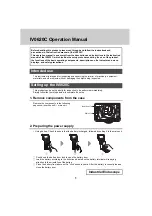
10-14
Triggering
/
↓
STEST — Event detection occurs when the SOT line of the Digital I/O port is
pulsed low. After selecting this arm event, you will be prompted to select the state
of the event detection bypass. With ONCE selected, operation will loop around
the arm event detector on each new pass through the trigger model. With NEVER
selected, operation always waits for the input trigger.
/
↑
STEST — Event detection occurs when the SOT line of the Digital I/O port is
pulsed high. After selecting this arm event, you will be prompted to select the
state of the event detection bypass.
/
↑↓
STEST — Event detection occurs when the SOT line of the Digital I/O port is
pulsed either high or low. After selecting this arm event, you will be prompted to
select the state of the event detection bypass.
-
ARM OUT
— Use to configure the arm layer output trigger:
/ LINE — Select the Trigger Link line for the output trigger: line #1, #2, #3, or #4.
/ EVENTS — Enable (ON) or disable (OFF) the arm layer output triggers. TRIG
LAYER EXIT ON enables an output trigger on exiting the trigger layer, while TL
ENTER ON enables a trigger on entering the trigger layer.
-
COUNT
— Specify the arm count, FINITE (programmable count) or INFINITE
(never ending count).
•
TRIG LAYER
— Use this menu item to configure the trigger layer of the trigger
model:
-
TRIGGER IN
— Use to select the detection event for the trigger layer:
/ IMMEDIATE — Event detection occurs immediately.
/ TRIGGER LINK — After selecting this trigger-in source, you will be prompted
in sequence as follows:
> TRIG-IN TLINK LINE — Select the input line (#1, #2, #3, or #4) for the
Trigger Link.
> EVENT DETECT BYPASS — Set the bypass for the Source Event Detector.
With ONCE, operation will loop around the Source Event Detector. With
NEVER selected, operation will wait for an input trigger.
> TRIGGER IN EVENTS — Enable (ON) or disable (OFF) trigger-in events
(SOURCE, DELAY, and MEASURE). With a trigger-in event ON, operation
will wait at that event for an input trigger. With the trigger-in event OFF, oper-
ation will not wait. It will simply continue on and perform the appropriate
action.
-
TRIGGER OUT
— Use to configure the trigger layer output trigger:
/ LINE — Select the Trigger Link line for the output trigger; line #1, #2, #3, or #4.
/ EVENTS — Enable (ON) or disable (OFF) output triggers that occur after the
source, delay, and measure actions.
-
DELAY
— Specify the time delay (in seconds) for the trigger delay.
-
COUNT
— Specify the trigger count.
Summary of Contents for 6430
Page 26: ......
Page 32: ......
Page 78: ...2 14 Connections ...
Page 98: ...3 20 Basic Source Measure Operation ...
Page 138: ...5 30 Source Measure Concepts ...
Page 156: ...6 18 Range Digits Speed and Filters ...
Page 168: ...7 12 Relative and Math ...
Page 176: ...8 8 Data Store ...
Page 202: ...9 26 Sweep Operation ...
Page 248: ...11 22 Limit Testing ...
Page 310: ...16 6 SCPI Signal Oriented Measurement Commands ...
Page 418: ...17 108 SCPI Command Reference ...
Page 450: ...18 32 Performance Verification ...
Page 477: ...A Specifications ...
Page 489: ...B StatusandErrorMessages ...
Page 498: ...B 10 Status and Error Messages ...
Page 499: ...C DataFlow ...
Page 503: ...D IEEE 488BusOverview ...
Page 518: ...D 16 IEEE 488 Bus Overview ...
Page 519: ...E IEEE 488andSCPI ConformanceInformation ...
Page 523: ...F MeasurementConsiderations ...
Page 539: ...G GPIB488 1Protocol ...
Page 557: ......
















































